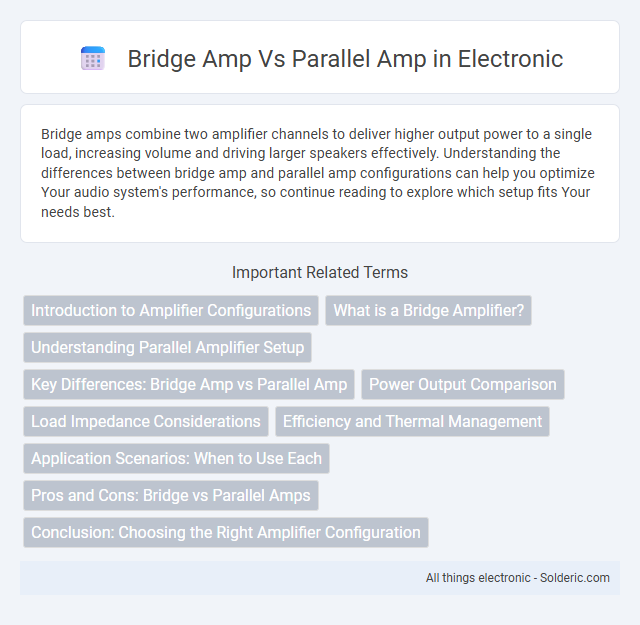Bridge amps combine two amplifier channels to deliver higher output power to a single load, increasing volume and driving larger speakers effectively. Understanding the differences between bridge amp and parallel amp configurations can help you optimize Your audio system's performance, so continue reading to explore which setup fits Your needs best.
Comparison Table
| Feature | Bridge Amplifier | Parallel Amplifier |
|---|---|---|
| Configuration | Combines two amplifier channels to drive a single load with doubled voltage swing | Uses multiple amplifier channels driving the same load to share current |
| Output Power | Higher power output, approximately four times the power of a single channel | Increased current capacity, effectively doubling available current per load |
| Load Impedance | Minimum load impedance is doubled compared to single channel | Load impedance remains same as single channel amplifier |
| Efficiency | Higher efficiency in power delivery due to voltage swing | Improved current delivery but efficiency depends on amplifier matching |
| Complexity | Requires phase inversion and careful balancing | Requires precise current sharing and closely matched amplifiers |
| Use Case | High-power mono output, subwoofers, and bridging stereo amps | High current applications, multiple drivers in parallel |
Introduction to Amplifier Configurations
Bridge amplifier configuration doubles output voltage by driving two amplifier channels in opposite phase to a speaker, effectively increasing power output without additional power supply voltage. Parallel amplifier configuration connects multiple amplifier channels in parallel to share current load, enhancing overall current capacity and improving reliability in high-load conditions. Each configuration optimizes amplifier performance based on power delivery requirements and speaker impedance characteristics.
What is a Bridge Amplifier?
A bridge amplifier combines two amplifier channels to drive a single load with increased power output, effectively doubling the voltage swing across the speaker or subwoofer. This configuration eliminates the need for a speaker ground connection by using one channel to provide the positive signal and the other to provide the negative signal. Bridge amplifiers are commonly used in car audio systems to maximize power delivery to subwoofers while maintaining efficiency and reducing distortion.
Understanding Parallel Amplifier Setup
A parallel amplifier setup involves connecting multiple amplifier channels to a single load, effectively sharing the current load and enhancing the overall power output while maintaining the voltage. This configuration improves reliability by distributing the electrical stress across several channels, reducing heat generation and potential distortion. In contrast to bridge amps, parallel amps maintain the original voltage level but increase current capacity, making them ideal for driving low-impedance speakers.
Key Differences: Bridge Amp vs Parallel Amp
Bridge amplifiers combine two amplifier channels to deliver higher power output to a single load, effectively doubling the voltage swing across the speaker, making them ideal for driving low-impedance speakers or subwoofers. Parallel amplifiers, on the other hand, distribute the same input signal across multiple amplifier channels simultaneously, providing increased current capacity to the load without increasing voltage. Your choice between bridge and parallel amps depends on whether you need increased voltage for power-heavy components (bridge) or enhanced current supply with shared amplification (parallel).
Power Output Comparison
Bridge amplifiers combine two amplifier channels to deliver significantly higher power output to a single load, often doubling the watts compared to a single channel. Parallel amplifiers distribute the input signal across multiple channels, maintaining power per channel but increasing current capacity and reliability rather than peak output. Bridge mode is favored in applications requiring maximum power efficiency, while parallel mode prioritizes balanced load distribution over sheer power.
Load Impedance Considerations
Bridge amplifiers typically operate with a minimum load impedance of 4 ohms to prevent overheating and damage, as they effectively double the voltage output to the speaker. Parallel amplifiers share the load across multiple amplifier channels, allowing you to use lower impedance loads such as 2 ohms without stressing individual amps. Understanding these load impedance considerations ensures optimal performance and protects your audio equipment from potential failures.
Efficiency and Thermal Management
Bridge amplifiers typically deliver higher power output by combining two amplifier channels, improving load handling but often generating more heat due to increased current flow. Parallel amplifiers share the load across multiple transistors or channels, enhancing efficiency and reducing thermal stress by distributing heat more evenly. Efficient thermal management in parallel amps allows for better reliability and longer lifespan compared to bridge amps, which require robust cooling solutions to prevent overheating.
Application Scenarios: When to Use Each
Bridge amplifiers are ideal for driving high-power speakers or subwoofers in car audio systems and public address setups where maximum output is needed from a single channel. Parallel amplifiers suit multi-speaker configurations such as home theater systems or distributed audio networks where preserving channel separation and minimizing distortion are crucial. Choosing between bridge and parallel amplification depends on whether the application prioritizes power output or channel independence for balanced sound distribution.
Pros and Cons: Bridge vs Parallel Amps
Bridge amplifiers deliver higher power output by combining two amplifier channels into one, making them ideal for driving a single subwoofer with maximum wattage; however, they may introduce distortion and require compatible speaker impedance to avoid damage. Parallel amplifiers distribute the signal across multiple channels simultaneously, offering greater flexibility for multi-speaker setups and improved reliability, but they typically produce less power per channel compared to bridged configurations. Choosing between bridge and parallel amps depends on the specific audio system requirements, such as power demands, speaker configuration, and impedance matching.
Conclusion: Choosing the Right Amplifier Configuration
Bridge amp configurations deliver higher power output by combining two amplifier channels into one, ideal for driving demanding speakers or subwoofers. Parallel amp setups distribute input signals across multiple channels, offering balanced power and improved load handling for multi-speaker systems. Your choice between bridge and parallel amplifiers depends on the specific audio needs, speaker impedance, and desired power output for optimal performance.
bridge amp vs parallel amp Infographic

 solderic.com
solderic.com